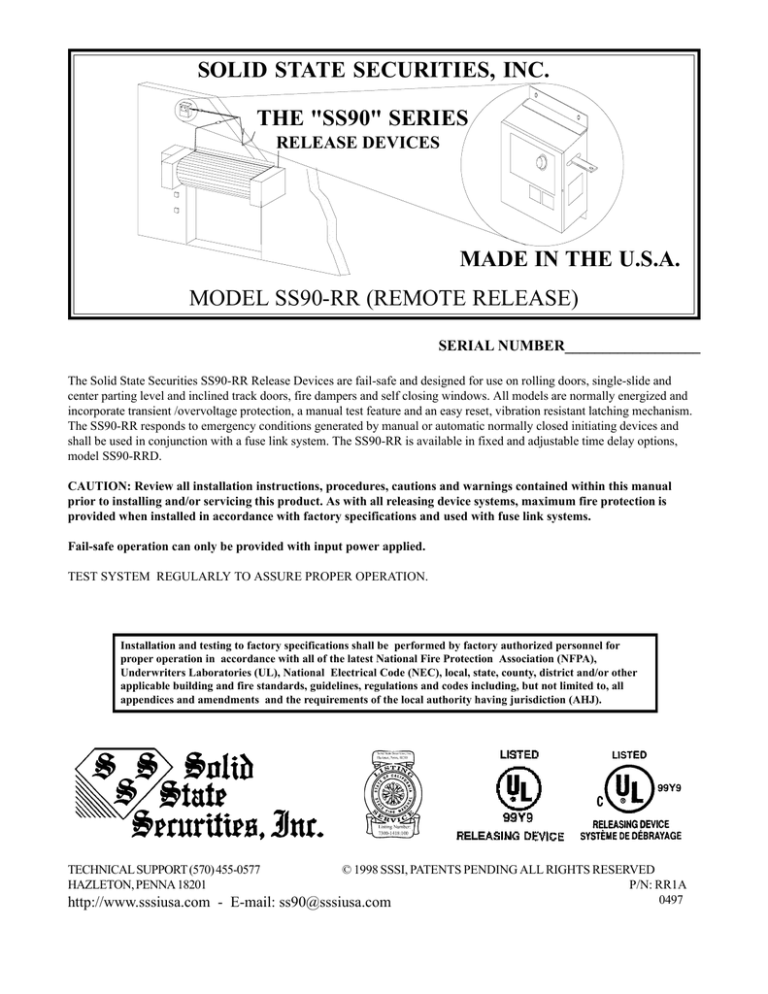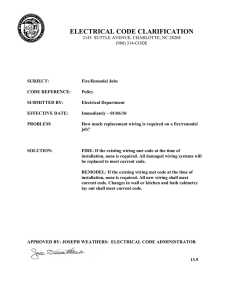
SOLID STATE SECURITIES, INC.
SSS
S S OLID
TATE
S ECURITIES,
SS
INC
90
SOLID
RESE
T
STATE
FAIL-SAFE
* PATENT
UNIT
PENDING
LISTED
U
L
99Y9
RELEASING
DEVICE
THE "SS90" SERIES
RELEASE DEVICES
MADE IN THE U.S.A.
MODEL SS90-RR (REMOTE RELEASE)
SERIAL NUMBER__________________
The Solid State Securities SS90-RR Release Devices are fail-safe and designed for use on rolling doors, single-slide and
center parting level and inclined track doors, fire dampers and self closing windows. All models are normally energized and
incorporate transient /overvoltage protection, a manual test feature and an easy reset, vibration resistant latching mechanism.
The SS90-RR responds to emergency conditions generated by manual or automatic normally closed initiating devices and
shall be used in conjunction with a fuse link system. The SS90-RR is available in fixed and adjustable time delay options,
model SS90-RRD.
CAUTION: Review all installation instructions, procedures, cautions and warnings contained within this manual
prior to installing and/or servicing this product. As with all releasing device systems, maximum fire protection is
provided when installed in accordance with factory specifications and used with fuse link systems.
Fail-safe operation can only be provided with input power applied.
TEST SYSTEM REGULARLY TO ASSURE PROPER OPERATION.
Installation and testing to factory specifications shall be performed by factory authorized personnel for
proper operation in accordance with all of the latest National Fire Protection Association (NFPA),
Underwriters Laboratories (UL), National Electrical Code (NEC), local, state, county, district and/or other
applicable building and fire standards, guidelines, regulations and codes including, but not limited to, all
appendices and amendments and the requirements of the local authority having jurisdiction (AHJ).
TECHNICAL SUPPORT (570) 455-0577
HAZLETON, PENNA 18201
http://www.sssiusa.com - E-mail:
© 1998 SSSI, PATENTS PENDING ALL RIGHTS RESERVED
P/N: RR1A
0497
ss90@sssiusa.com
INSTALLATION INSTRUCTIONS - To be performed by factory authorized personnel only.
The following installation procedures must be followed to assure performance of the release device to factory standards. All
hardware, fusible links and chain or cable shall be furnished by door manufacturer or installing company and shall be
approved or recognized as required for use with this product.
SECTION A. MOUNTING PROCEDURE (Figures 1 & 1A)
1. The release device shall be mounted on a vertical surface with chain end link exiting side of enclosure as illustrated in
figure 1 (horizontal pull) or 1A (vertical pull).
2. Release device enclosure shall be mounted with minimum #10 size fastening screws or bolts for securing to structures
other than masonry. Masonry applications shall utilize 1/4" or greater anchors or studs as required to insure proper
mounting strength.
3. Release device and associated hardware [sash chain or 1/16 cable, eyebolts, fuse links ( do not install this unit without
fuse links), turnbuckles] shall be installed as per door manufacturer recommendations (fig. 1 & 1A typical installation
configuration). Note should be taken that the end link direction of pull is perpendicular to the enclosure side. An eye
bolt installed at a distance of 18 to 24 inches from the release device should adequately redirect sash chain pull as
illustrated in figures 1 and 1A.
4.Complete hardware installation by connecting fuse links, sash chain, S-hooks and turnbuckles as required. Reset
release device by depressing reset knob in until latch clicks into locking position Push end link into opening of
release mechanism while holding tension from release arm. Release rest knob. Release device is now set.
SECTION B. Smoke Detectors.
When installing smoke detectors with this unit refer to NFPA 72-1993 and NFPA 80, paragraph 6-6 for instructions
concerning proper placement and detection coverage.
SECTION C. ELECTRICALCONNECTIONS -All models (Figure 3- stand alone, Figure 3A- Delayed Daisy Chain)
Installation of all wiring and connections shall be performed in accordance with, but not limited to, the latest NFPA,
U.L. and N.E.C. standards. In addition, all installations subject to Canadian standards shall be performed in accordance
with the Canadian Electrical Code, Part I, with respect to wiring material, wiring gauge related to power capacity
requirements and circuit length and wiring methods.
I) Stand alone use (Figure 3) The model SS90-RR does not provide delay in power loss or alarm. Use the SS90-RRD if
the installation is stand alone and a delay is required
1. Turn off power supply before beginning.
2. Verify voltage rating of release device to power source being utilized.
3. Connect power source inputs (through normally closed initiating device) to red (+) and black (-) wires. Observe
proper polarity. Install chassis ground where applicable. Do not connect (-) to chassis ground.
II) Delayed Daisy Chain - SS90 Series Models SS90-B2 Master & SS90-C. Daisy chain configuration provides time
delay feature from master unit (Model B2 Master or SS90-C). Independent delays are set inside master unit. 10 second
alarm (factory set) and battery support for power loss. Use only the SS90-RR in daisy chain configuration to avoid
doubling the time delay. DO NOT use the SS90-RR-24 when using the Daisy Chain configuration.
1) Run two wires (18 gauge) from master unit to first SS90-RR-12. Run two wires (18 gauge) between each Remote.
Maximum of three (3) units.
2) Connect red (+) wire from SS90-RR-12 to wiring from TB1-15 and black wire to wiring from TB2-1. (Connections
are identical to both SS90-B2 Master & SS90-C). Review Figure 3A for additional wiring required inside of master
unit.
Verify connections made within unit. Close cover and secure screw-on lid after all connections are made.
DO NOT LEAVE COVER OPEN AFTER CONNECTIONS ARE MADE!
1
FIGURE 1
SS90-RR
SS90-RRD
Horizontal pull
FIGURES 1 AND 1A DEPICT MOUNTING OPTIONS FOR REMOTE RELEASE AND
ARE NOT PROVIDED AS GUIDELINES FOR THE INSTALLATION OF THE DOOR OR
ASSOCIATED HARDWARE. SEE DOOR MANUFACTURERS RECOMMENDATIONS
AND NFPA 80 FOR USE OF THIS PRODUCT, FUSIBLE LINKS AND ASSOCIATED
HARDWARE USED WITH SPECIFIC DOOR. ACTUAL CONFIGURATION MAY VARY
SIGNIFICANTLY FROM ILLUSTRATIONS PROVIDED.
FIGURE 1A
SS90-RR
SS90-RRD
Vertical pull
2
SS91-RR INSIDE VIEW (Cover removed)
FIGURE 2
Reset Knob
Power L.E.D.
Manual Test Button
FIGURE 3 - ELECTRICAL WIRING
(2) Initiating Device (Smoke detector, etc.)
(+)
(1) Input power
(-)
RED
BLACK
SS90-RR (REMOTE RELEASE)
SS90-RRD (DELAY OPTION)
(+)
(-)
Chassis ground
(1) Verify input voltage to model being used.
(2) See NFPA 80 and NFPA 92-1993 for proper placement.
Installation of all wiring and related connecting hardware must be performed in accordance with the latest NFPA, U.L., and N.E.C. standards and codes. In
addition, all installations subject to Canadian standards shall be performed in accordance with the Canadian Electrical Code, Part I, with respect to wiring
material type, wiring gauge related to power capacity requirements and circuit length and wiring methods.
3
FIGURE 3A - ELECTRICAL WIRING : TIME DELAY DAISY CHAIN CONFIGURATION
SMOKE DETECTOR
OR ALARM PANEL
NORMALLY CLOSED
DRY CONTACT LOOP
(5)
SS90-B2 Master
OR SS90-C
1
(2)
TB-1
1
2
3
RED
(+)
(-)
(+)
(-)
BLACK
RED
SS90-RR
#3
SS90-RR
#2
BLACK
(4)
14
15
(+)
RED
SS90-RR
#1
(1)
BLACK
18
(3)
(+)
(-)
18
1
2
(-)
TB-2
Refer to page 1, Section C for wiring descriptions.
Wiring of the remote releases in a Daisy Chain configuration to a master unit (SS90-B2 Master or SS90-C) provides time delayed release
with simultaneous closure on all doors. A maximum of three (3) units may be daisy chained from the master unit.
(1) Verify model being used as SS90-RR-12. Do not use SS90-RR-24.
(2) See NFPA 80 and NFPA 92-1993 for proper placement. Electrical supervision of detector shall be provided as per U.L. 864
(3) Install jumper between TB2-2 and TB1-14 of master unit.
(4) Wiring betweeen units is parallel connected. DO NOT series connect units.
(5) Illustration does not depict entire master unit. See installation manual of master unit for additional information.
Installation of all wiring and related connecting hardware must be performed in accordance with the latest NFPA, U.L., and N.E.C. standards and codes. In
addition, all installations subject to Canadian standards shall be performed in accordance with the Canadian Electrical Code, Part I, with respect to wiring
material type, wiring gauge related to power capacity requirements and circuit length and wiring methods.
3A
"SS90" SERIES RELEASE DEVICE ELECTRICAL AND MECHANICAL CHARACTERISTICS
ELECTRICAL RATINGS
MODEL (D- delay option) VOLTAGE
MIN.
MAX.
CURRENT
SS90-RR-12 / SS90-RRD-12 12VDC
SS90-RR-24 / SS90-RRD-24 24VDC
10.2
20.0
15.0
28.0
.050A
.050A
MECHANICAL- LOAD RATING
Support and release: 40LB. MAXIMUM
DIMENSIONS
6" x 4 " x 3 1/8" (H x W x D)
SECTION D. TEST PROCEDURES
TO BE PERFORMED BY FACTORY AUTHORIZED PERSONNEL ONLY! SOLID STATE SECURITIES
RECOMMENDS REGULAR TESTING OF ALL RELEASE DEVICE EQUIPMENT. TESTING SHALL BE
WITNESSED FOR PROPER OPERATION.
Testing does not affect normal operation of alarm system when connected to release device. Testing and normal operation can only be accomplished with
power applied to unit. When power is applied to unit under test the Power LED (red) will be lit on the bottom of the release device.
Testing of the SS90-RR release device is independent of, and shall in no way be interpreted as an alternative method of, testing of the fire alarm
system, motorized operator and/or any other system component employed on the fire door or counter fire door installation.
CLEAR FIRE DOOR OPENING AND PROHIBIT ALL TRAFFIC THROUGH DOOR OPENING DURING
TESTING OF SYSTEM!
Door must be in open position with power applied to unit and/or master unit on Daisy chain configurations.
I)
Stand alone use SS90-RR.
1. Depress test button on side of release device (figure 1). SS90 release device will immediately release door.
Release test button.
2. Reset and raise door. Reset release device by depressing reset knob in until latch clicks into locking position
Push end link into opening of release mechanism while holding tension from release arm. Release rest knob.
Release device is now reset. Allow a minimum of 25 seconds between tests of release device.
Ia.) Stand alone use SS90-RRD.(Delayed unit)
1. Depress and continue to hold test button on side of release device (figure 1). After 10 sec. (+/- 2 sec.) delay unit
will release door. Release test button.
2. Reset and raise door. Reset release device by depressing reset knob in until latch clicks into locking position
Push end link into opening of release mechanism while holding tension from release arm. Release rest knob.
Release device is now reset. Allow a minimum of 25 seconds between tests of release device.
II) Daisy Chain use. Model SS90-RR only.
1. Depress and continue to hold chassis mount test button on master unit. After 10 second delay (factory adjusted)
all Remote Releases will close simultaneously. Reset as described above.
Allow a minimum of 25 seconds between tests of release device.
After completing all tests, make sure door is in its normally open position and all power required for normal operation is restored to unit. This unit is designed to operate with power applied.
REMINDER:
Testing of the "SS90-RR" release device is independent of, and shall in no way be interpreted as an alternative method of, testing of the fire alarm
system, motorized operator and/or any other system component employed on the fire door or counter fire door installation. TESTING SHALL BE
PERFORMED AND WITNESSED FOR PROPER OPERATION.
MAINTENANCE REQUIREMENTS
The Model SS90 Remote Release Devices have no scheduled maintenance requirements. The unit has been designed and tested for use in indoor locations.
Solid State Securities recommends regular testing of the unit, with testing performed a minimum of once annually as per appropriate standards, but test
intervals shall ultimately be subject to criteria established by the Final Authority Having Jurisdiction (AHJ).
Should servicing of equipment be required, personnel authorized to perform such maintenance shall ensure that; a) all traffic is prohibited thru door opening,
b) door is mechanically released and fully closed, c) all power is disconnected from unit. After servicing equipment as required, unit shall be tested and
witnessed for proper operation as described in SECTION D- TEST PROCEDURES, contained herein.
4
NOTES/TEST RECORDS
Copy this sheet and attach to manual for additional test data as required. Maintain test records in a secure
location for future reference.
UNIT SERIAL NUMBER: ________________________
TEST DATE
PERFORMED BY
WITNESSED BY
TECHNICAL SUPPORT (570) 455-0577
5
COMMENTS
SS90-RR & SS90-RRD TROUBLESHOOTING GUIDE
Verify that desired options are available on unit before troubleshooting. Refer to electrical connection information and wiring
diagrams of this manual. Troubleshooting shall be performed by factory authorized personnel only. Service and/or installation
by unauthorized personnel shall void warranty. Review the following guide prior to requesting technical support. When using
Daisy Chain configuration, call tech support before troubleshooting. If technical support is required, unit serial number
(found on front of manual and inside unit), as well as distributor who supplied unit must be provided. Should servicing of
equipment be required, personnel authorized to perform such maintenance shall ensure that; a) all traffic is prohibited thru
door opening, b) door is mechanically released and fully closed, c) all power is disconnected from unit. After servicing
equipment as required, unit shall be tested and witnessed for proper operation as described in SECTION D-TEST PROCEDURES, contained herein.
SYMPTOM
POSSIBLE TROUBLE
1. Red Power LED does not light.
A) Primary power source turned off.
B) Loose connection on Red or Black wire
C) Incorrect polarity on unit
D) Master unit fuse blown. Call tech support.
E) Incorrect power source applied. Verify voltage
and call tech support.
2. Red LED is on, but unit does not release door
after alarm or power loss delay.
A) Power loop is not connected to proper power
source. Disconnect Red and Black wires.
Measure power source. 10.2-15V SS90-RR-12
20.6-30V SS90-RR-24
B) N/C Alarm loop not opening.
Place smoke detector in alarm and verify that
contacts open on alarm disconnecting power.
C) Wiring incorrect on Daisy Chain master unit.
Call tech support.
D) Load on Release mechanism exceeds 40lbs or
is not pulling perpendicular to unit.
E) Damaged unit. Call tech support.
3. Red LED is on, unit does not respond to manual
test button, but works in alarm.
A) Test button is not being depressed long enough
on Master unit or individual unit. Depress
button continuously for the 10 second delay
(RRD). Unit must be powered up for a minimum of 25 seconds before initial test and
between sunsequent tests.
B) Possible defective switch. Call tech support.
UNIT SERIAL NUMBER___________________ DISTRIBUTOR___________________
TECHNICAL SUPPORT (570) 455-0577 9AM - 5PM EST MON-FRI
6



